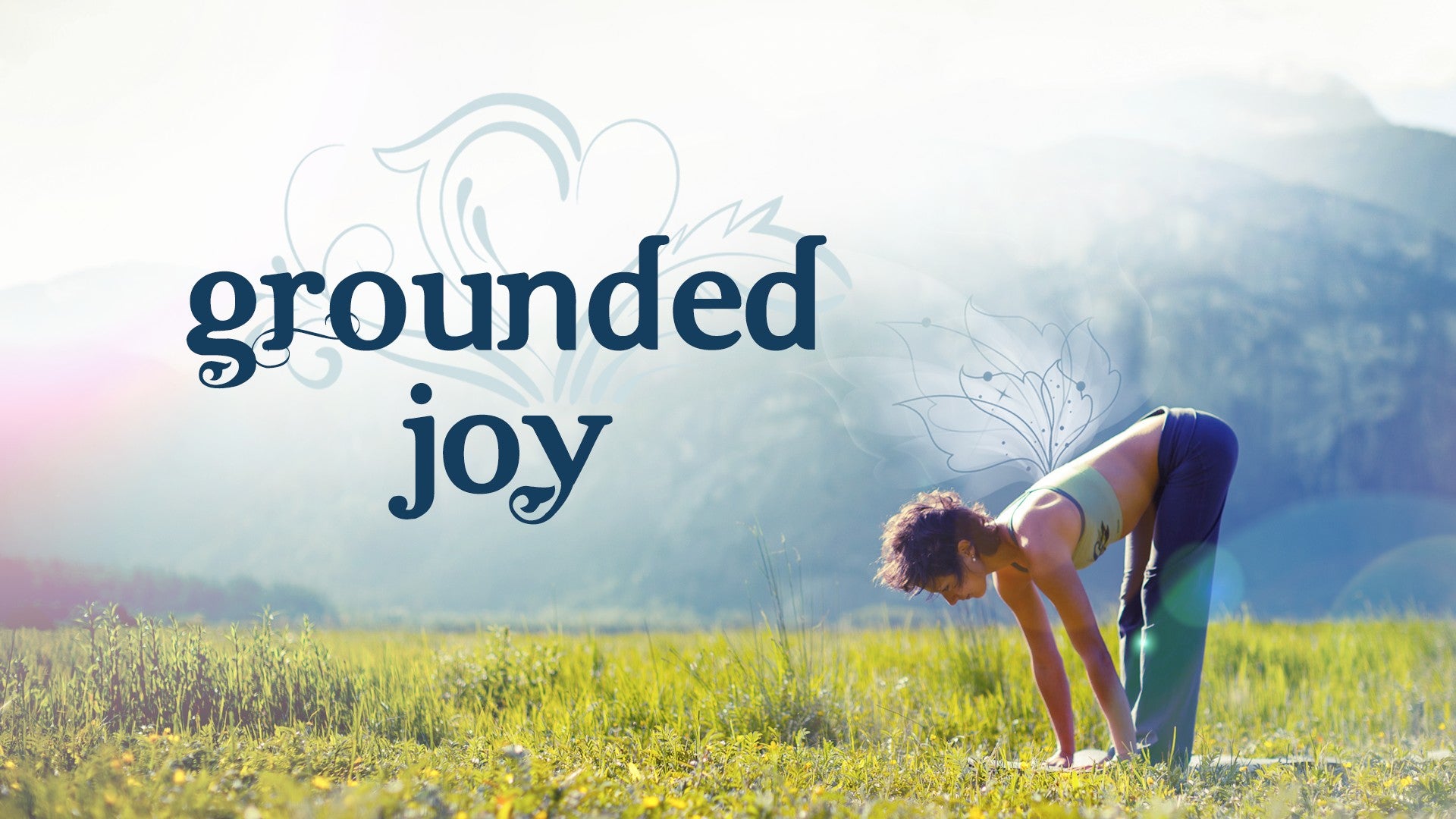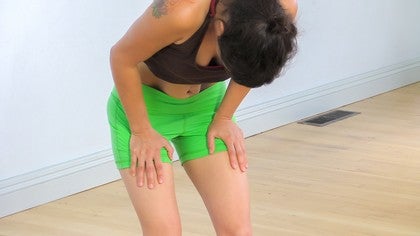Description
About This Video
Transcript
Read Full Transcript
Hi, we're gonna look at a kriya which is a cleansing practice called uddiyana bandha. But it's not the uddiyana bandha that's more subtle, that is just the very gentle drawing upwards of the lower abdomen back up towards the spine, it's the kriya of uddiyana bandha, which is a strong suction, like a vacuum cleaner in your lower belly, of drawing the lower abdomen back towards the spine, and lengthening out the spine. This practice is really useful for cleaning out the guts, the digestion, and also for tractioning the lumbar spine. So let's come up to standing, if you're not already up and standing. Take your feet pretty wide, a little bit wider than hip distance apart.
And I'm just gonna show you my belly here, so that you can really see what's going on. One thing that I should mention to you is that if you have eaten anything, like bigger than the palm of your hand (laughs), this practice is gonna be a no go. So you might just wanna watch. Not that it's bad to do it, but you might feel a little bit nauseous, or the actual suction won't really happen at all because there's stuff in the guts. Also don't practice this at all if you're pregnant.
So let's come down like this, and I just have to say too, that I would usually place my hands down here on my knees, and kind of curl quite a bit in this practice. But you won't be able to see my belly, so I'm actually gonna come up a little bit higher, but could take your hands down on your knees like this. And some people actually find this class really useful, is to turn the fingers in, so the back of the body's quite a bit wider. Kind of like that, but just so that I can show my belly, I'm gonna come up a little bit higher like this. So we take a huge inhale (breathes deeply), and an exhale out of the mouth, and exhale everything (breathes deeply).
Only when everything is exhaled, we let the belly hang, totally relaxed, like you're kind of three months pregnant (breathes deeply). And then without breathing here, we're going to do a mock inhalation. So like the action that you would do on an inhalation, widening the ribs, kind of coming up, and suction the belly back towards the spine and up. Let's just try that again. So inhale (breathes deeply), exhale fully (breathes deeply), let the belly go.
Let the belly go again, let the rest of the exhale go (sharp breath) and then inhale come up to standing. So it's sort of feels like, I've heard this before from one of my teachers, but like a toilet plunger, like really like sucking back and up. And it's, it's, I mean it's not forceful in the way that it creates tension, but it's deep in the way that it really hollows out. It feels like the diaphragm, the dome of the diaphragm, really steeples up into the space of the lungs. So everything just kind of carves out a ton of space in this area.
And you know what, as when we were kids, I remember actually always just going, "Hey, look at this," and doing that action and standing. You know, look at how skinny I can get (laughs). But um, with my brothers and sisters, I have four brothers and sisters. So it's kind of a natural thing to do as kids. It feels good, and it's an interesting sensation.
Let's take it one step further. So what we're gonna do now is do agnisara, which is pumping the belly back up, and then letting it relax fully, again like you're three months pregnant, and then pumping it back up and relaxing it fully, but all empty of breath on the exhalation breath. So I can't stress that enough, don't breathe in when you're doing this. And let's just start with three pumping, and then I'll just do a demo for you to see where you can maybe make the pumping a bit faster. But if you're just creating more tension in your diaphragm and your belly, it's better to do like, less is more, for sure.
So again, you come down here, and maybe even like this. I'll come up here, and we're gonna inhale fully, exhale everything (breathes deeply). And kind of letting, like the primary curve come into my spine, so a little bit of a curl (breathes deeply). (sharp breath) Exhale the rest out, and come up. So what's really neat about that, and I didn't mention it, but I just experienced it, and it's lovely, is that there's sort of a natural jalandhara bandha that happens.
This is the chin lock, when the chin, sort of like the occiput slides forwards on the top vertebrae of the spine, and comes into that notch in-between the collar bones. Another little lovely thing that might happen is that that space in-between the collar bones actually deepens, and there's another little bandha here that kind of dimples back towards the C7, creating a ton of space in the C7, and actually all the vertebrae of the spine. So I'll give just a demo. That's something that you can practice, and I'll give you a demo of it a little bit faster (breathes deeply). (breathes deeply) What's neat about that is that you can play with really using the abdominal muscles that are super deep, and really letting your front abdominal wall relax.
Which is actually really useful in a lot of the yoga asanas is to keep the front wall of the belly relaxed, and the deeper abdominal muscles strong. Let's take this one step further again, and see if we can release the rectus abdominis which is, like what you'd see on some people as a six-pack, and it's the most superficial wall of abdominal muscles. We're gonna release that forwards, those muscles. But then here you'll see that the transverse abdominal muscles that are way deep, kind of like the corset that protects your spine a bit, and that are the deepest layer of abdominal muscles, they're gonna suction back. So you sort of have control over those, and then you release the superficial belly wall, which again, is super useful.
And the once you can do that, you can turn it into nauli which is the churnings, which you may have seen before, and I'll demo it. The churning of that rectus abdominis structure, and it's sort of like one of those old washing machines, like really cleaning out any tension in the back, any stickiness in the spine, and any stuckness in the intestines even. I'll show you what it looks like, and then the way that I learned to do it is actually to grab the rectus with the heels of my hands and pull it out. So I'll give you a demo of what it looks like, and then I'll show you how you can work towards it. So again, inhale (breathes deeply), exhale everything (breathes deeply), let it go.
So I'm gonna suck everything back up after I do that, and release, and come up. Exhale everything and come up. So to practice that, let's just take a look at grabbing it and pulling it forwards. So inhale, remember you're down here, exhale everything (breathes deeply), empty your breath, full empty, release everything. It's just a good practice to release your belly (breathes deeply).
Okay, so you actually pull it, grab it, move it forwards, and see if behind that you can get a sense of drawing back towards the spine. I would recommend that if you're gonna do this, do it in the morning in the shower is a great time to do it. It's great before you eat, and also get a mirror. See if you can take a look at what's happening in your belly, it's really helpful. And then lastly, I'm just gonna give you a quick demo of nauli, of the churnings, which is a cleansing practice.
And a way that you can work towards this is if you start to get that real hollow feeling, all you do is hula hoop your hips one way, and then the other. It's like really nice to just get this feeling in your hips. Often in our culture we're really stuck in this area. It's kind of like counter-culture to like move your hips around. Also like everything about this practice is just really nice.
So I'll show you what it looks like. So first you start by kind of hula hooping, and then you can get the control of keeping your hips steady, and then getting the churnings to still happen. So (breathes deeply). And it's neat for me because I'm actually coming back into this practice after being pregnant where I had quite amazing control. And now it's kind of like, it's a little bit jagged.
I'm getting it back because things got disconnected, and organs moved around. But I'm finding this just an amazing way of regaining a sense of inhabiting my belly area again, but just me, and it's bee amazing for that healing process, and bringing everything back together. So you can start with those hula hoops, and see how it goes. Thank you for watching, namaste.
Grounded Joy
Comments
 Thank you.
Thank you.
For some reason I just read this now.
I loved your subtle core work video! Thanks for watching and I'm so looking forward to meeting you in person soon. Love!
You need to be a subscriber to post a comment.
Please Log In or Create an Account to start your free trial.











